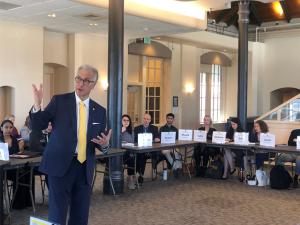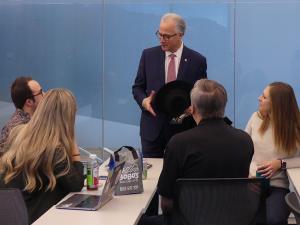Five questions for Mark Kennedy
Less than a year after taking his post, CU President Mark Kennedy confronted a time unlike any other in university history.
“We’re navigating through five turbulent forces: The worst pandemic since 1918; a deep recession that has strangled economic activity; the most intense focus on civil rights since the 1960s; and arguably, the greatest political divisiveness since the Civil War. Further compounding these, COVID has sparked a tech-celeration that is fundamentally changing our lives,” Kennedy said.
As 2020 comes to an end, the president is encouraged by how CU has fared.
“Through it all, CU has adapted and continues to deliver on our mission in teaching and learning. We’re unlocking discoveries that help solve complex societal challenges, nurturing entrepreneurship and serving our communities,” he said.
Kennedy points to how CU led the state in moving to remote teaching on March 11 and seeking vital federal funding, outperforming peer institutions in spring enrollment, adjusting to facts on the ground and helping to advance therapeutics and vaccines that will help move CU beyond the pandemic.
As he reflects on the past nine months, a key takeaway:
“I’m greatly appreciative of the faculty and staff who made this possible.”
1. COVID necessitated pauses in three of the biggest projects across the system: strategic planning, the CU Online initiative, and the Transformation and Innovation Program. Did those pauses and other pandemic-induced hurdles hurt progress?
The system’s strategic planning process will resume at the beginning of the year toward a final presentation to the Board of Regents in July. The pause allows us to be responsive to the technological acceleration the pandemic caused. While our online initiative and Transformation and Innovation Program have had to proceed at a more measured pace to permit an intense focus on responding to the pandemic, the behaviors spurred by the pandemic affirm their necessity. They will continue to be a priority requiring increased coordinating and sustained effort in the months and years ahead.
Additionally, we’re bolstering our Diversity, Equity and Inclusion leadership across the system and have major efforts underway, fueled in part by a newly established a $5 million Diversity, Equity and Inclusion Innovation Fund to spark further progress in this area.
2. What do you expect to see for spring semester?
Campuses will begin releasing their plans for spring today. As we’ve looked at the surge that occurred over Thanksgiving and the additional surge we expect over the upcoming holiday, we’re working closely with public health authorities to chart the best balance between continuing to deliver on our mission and the health of our communities.
While I expect we’ll begin the spring semester more aligned with how we ended the fall semester than how we began, we’ll continue to keep a close eye on the facts on the ground and keep in close coordination with public health authorities. The strong partnership we’ve developed with public health officials and their development of a dial to guide actions will prove valuable.
Our campuses have elevated their testing capacity. As the vaccine rolls out, I hope that as the semester evolves, we’ll be able to incrementally move back to more normal interactions, allowing for more engagement among our students.
3. With a vaccine on the horizon, will CU have a role in its rollout?
We all welcome the hope that comes along with reports of imminent distribution of vaccines. CU Anschutz has participated in more than 40 clinical trials and studies, including clinical trials for the Moderna vaccine now awaiting FDA approval. Vaccines are essential to bringing this pandemic under control.
The vaccines will be rolled out in phases, with the prioritization and distribution ultimately directed by federal, state and local health authorities and the process will vary by vaccine. Expertise from around CU is informing our discussions on logistics, timing, communication and prioritization of recipients within federal and state guidelines.
In the first phase of the distribution, we’ll coordinate with our hospital partners at CU Anschutz; the Auraria Campus at CU Denver; and public health authorities at CU Boulder and UCCS to distribute the limited number of doses available to reach health care workers who are exposed to patients and infectious materials. As this phase evolves, doses will be prioritized to essential workers and people at higher risk of severe COVID-19 illness, including those age 65 and older.
Each campus will likely have a bigger role as we move to phase two when more doses are available. After we address the priority populations, we’ll follow with other critical populations that have frequent exposure to the public, and ultimately, provide the vaccine to the general population. Vaccine distribution will require surmounting many logistical challenges.
You’ll hear more from your campus (or from system, for system administration employees) in the coming weeks as plans become clearer and issues resolved. We understand many questions will arise, and timely and thorough communications are important. We’ll keep you apprised of progress and, again, thank you for all you do to help CU navigate this tumultuous time. Hope is on the horizon.
4. What are your impressions of how CU’s faculty, staff and students navigated the pandemic?
We’ve traveled some challenging roads together in recent months, facing a relentless stream of hurdles. All of us have had to find places in our homes to work, often in competition with family members, we’ve had to juggle ever-changing school schedules for children, contend with isolation from our families and friends, and wrestle with anxieties and fears.
The economic impact of the pandemic and resulting economic downturn has necessitated budget constraints, including furloughs or temporary pay-cuts for all those making above $60,000. I appreciate each CU employee for working so hard while receiving less during this period.
As we prepare for the next fiscal year, we’re currently planning to lift furloughs and temporary pay cuts no later than July 1, 2021. Each campus will determine the extent to which their financial conditions may permit lifting furloughs and pay cuts before then and provide paid administrative leave to recognize our appreciation.
CU has been able to navigate today’s turbulent environment because of the diligence and dedication of our faculty and staff. I am grateful for and in awe of your collective efforts and how they enable CU to continue to benefit Colorado and beyond.
5. What do you expect to see in the upcoming legislative session and in CU’s 2021-22 budget?
While Gov. Polis’s 2021-22 budget request returns higher education funding to last year’s level, it doesn’t account for the impact of inflation over the two-year period. We’re working closely with the state’s other universities to correct this.
My op-eds in The Denver Post and other publications around the state pressing the need for state financial support is just part of our sustained effort advocating for more state funding.
We’re also watching closely for movement on additional federal stimuli and will again be engaging the state’s other universities to join us in appealing to our federal delegation for pandemic aid. The result of federal funding could provide additional support directly to our students, to institutions such as CU and to the state. Additional state support in a federal stimulus bill would hopefully result in a positive response to our budget requests.
My joint editorial with UMass President Marty Meehan in a Washington, D.C., publication in September on how Washington’s inability to agree on COVID relief puts the future of higher education at risk is part of our sustained effort advocating for federal support.
We’re also advancing other initiatives, including the flexibility to allow in-state tuition for members of Indigenous tribes who called Colorado home. Our government relations team is working with other universities to advance enabling legislation in the upcoming session.





